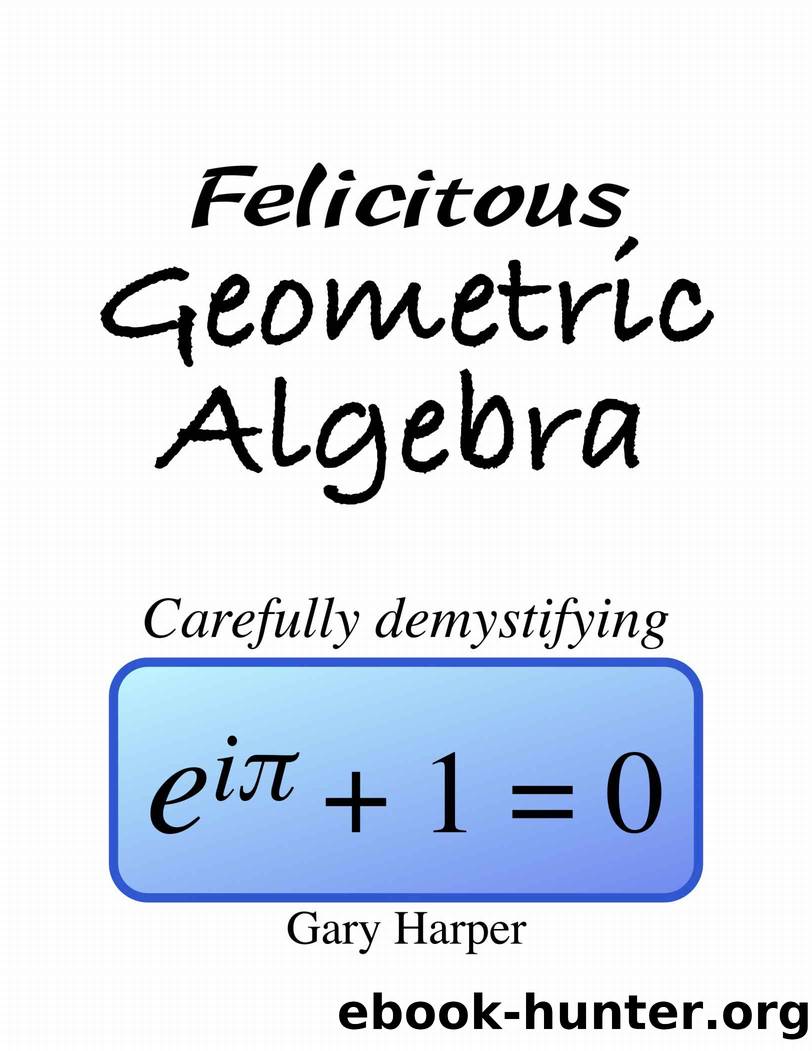Felicitous Geometric Algebra: Carefully demystifying Euler's Identity by Gary Harper

Author:Gary Harper [Harper, Gary]
Language: eng
Format: azw3
Published: 2018-10-28T00:00:00+00:00
Elements for physical space. Dashedâlines meanâ+
You already know that free vector v on top left is the free part of bound v on bottom left. In a similar way, free bivector B on top is the free part of bound B on bottom:âits extension with any point in bound B's confining plane generates bound B. To see that, place one end of free B on the point before extending, just as with a free vector. Poof!âthat part of the extension vanishes leaving a bound vector extended to a point, a bound bivector. Similarly for trivectors T and T. This process exposes a crucial ambiguity and an apparent incongruity.
The ambiguity is that there are always two distinct ways to generate a bound n-vector:âeither by extending a bound (nâ1)-vector to a point, or by extending a free n-vector to a point. This is crucial because it means that undoing extensionâretractingâhas two options:âa free result or a bound one. So which does it choose?
Those options seem to induce the incongruity that the same dimension arises from arguments with different dimensions. This is superficialâthose arguments in fact do have the same numeric dimension when you carefully distinguish free from bound, like so:
Whereas a free n-vector has dimension {n}, just as in the conventional free algebra, a bound n-vector has dimension {n+1}, already seen in extensions up from the floor. At the floor, a bound 0-vector is a point, dimension {1}; a free 0-vector is a scalar, dimension {0}. Going up, a bound 1-vector is a line segment, dimension {2}; a free 1-vector is a roving bundle of points, dimension {1}, and on up.
In short, the n in an n-vector, free or bound, tells its spatial expanse. To discover its numeric dimension, you need to know whether that expanse was generated by n+1 fixed points, or by n roving expansive bundles of them.
Said differently, perhaps better, once you know the n-expanse, you need to further discover whether it is filled-in or emptyâgenerated by n+1 points or by n free vectors. Such careful free-versus-bound distinctions dispelâand even somewhat accommodateâour timeworn EuclideanâCartesian confusion about the dimensions of scalars, points, lines, planes and on up.
So, back to the non-superficial question:â¿Which option does retraction choose? Free result or bound result? It becomes clear when you realize that retractionâin order to eventually combine with extensionâmust scale like extension does.
This means that retraction should be able to scale either its retractee, or its result, indifferently. For a bound result, these different kinds of scaling would produce things in different locations with different magnitudes. Conversely, a free result has no fixed location to differ from; and for it, the different kinds of scaling simply scale the separation of what is produced, indifferently.
Consequently, retraction must produce a free result. This is somewhat intuitive:âundoing extension naturally loses the locus information extension had gained.
However, there is an important subtlety: the just-mentioned contradiction for a bound result is geometric, not algebraic. The exact same algebra, for a free result, fails to generate a contradiction. Here you see semantics disciplining syntax, contrary to mathematical fashion for the last four centuries.
Download
This site does not store any files on its server. We only index and link to content provided by other sites. Please contact the content providers to delete copyright contents if any and email us, we'll remove relevant links or contents immediately.
| Applied | Geometry & Topology |
| History | Infinity |
| Mathematical Analysis | Matrices |
| Number Systems | Popular & Elementary |
| Pure Mathematics | Reference |
| Research | Study & Teaching |
| Transformations | Trigonometry |
Modelling of Convective Heat and Mass Transfer in Rotating Flows by Igor V. Shevchuk(6408)
Weapons of Math Destruction by Cathy O'Neil(6220)
Factfulness: Ten Reasons We're Wrong About the World – and Why Things Are Better Than You Think by Hans Rosling(4715)
A Mind For Numbers: How to Excel at Math and Science (Even If You Flunked Algebra) by Barbara Oakley(3259)
Descartes' Error by Antonio Damasio(3249)
Factfulness_Ten Reasons We're Wrong About the World_and Why Things Are Better Than You Think by Hans Rosling(3218)
TCP IP by Todd Lammle(3157)
Fooled by Randomness: The Hidden Role of Chance in Life and in the Markets by Nassim Nicholas Taleb(3082)
Applied Predictive Modeling by Max Kuhn & Kjell Johnson(3043)
The Tyranny of Metrics by Jerry Z. Muller(3031)
The Book of Numbers by Peter Bentley(2933)
The Great Unknown by Marcus du Sautoy(2664)
Once Upon an Algorithm by Martin Erwig(2624)
Easy Algebra Step-by-Step by Sandra Luna McCune(2606)
Lady Luck by Kristen Ashley(2556)
Police Exams Prep 2018-2019 by Kaplan Test Prep(2517)
Practical Guide To Principal Component Methods in R (Multivariate Analysis Book 2) by Alboukadel Kassambara(2514)
All Things Reconsidered by Bill Thompson III(2373)
Linear Time-Invariant Systems, Behaviors and Modules by Ulrich Oberst & Martin Scheicher & Ingrid Scheicher(2348)
